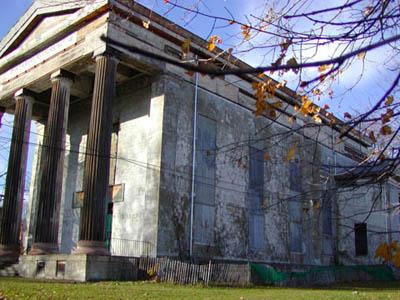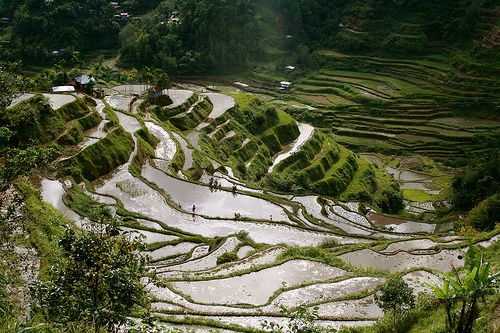Talking Preservation with the World Monuments Fund
Every two years* the World Monuments Fund (WMF) releases its “Watch List” of cultural heritage sites around the world that are in danger of disappearing. This year, we noticed that one of our favorite Atlas places appeared on the list: Las Pozas in Mexico

Las Pozas, via Flickr
Las Pozas is a garden of surreally over-sized installations in concrete and stone. It was the vision of an English eccentric in the 1960s, and was built in the Mexican jungle over the course of 25 years. According to the WMF Watch List report, “Since his death, the jungle has become increasingly interwoven with the structures, and the landscape has become more compelling than ever. Nevertheless, if allowed to grow unchecked, the tropical trees and plants threaten to overwhelm the equally exotic architecture.”
Although I had heard of them before, I first saw the impact of the WMF last spring in Cambodia.
For me, seeing the work that they are doing to save the monuments at Angkor was truly inspiring. Right now, they are in the process of preserving the 70 meter long bas-relief telling the story of the Hindu origin story “The Churning of the Sea of Milk”. In order to save it from water erosion, they have had to systematically remove, repair, and replace the mortar-less 12th century arched roof that protects the gallery from the elements.
Walking around the preservation area, it was clear hugely diverse skill sets were needed - from historians and artists, to geologists and biologists, to engineers and construction foremen - not to mention an administrative staff able to handle the logistics of planning massive operations in far flung locations, often, like Angkor, far from support systems we are used to in less remote places.
Seeing the hands-on work that goes into making sure that these places are around for future generations is awe inspiring.
Recently I spoke with Lisa Ackerman, Executive Vice President of the WMF, about their role in protecting forgotten places, and how the rest of us, as interested parties and as travelers can help them accomplish that goal.
She began by explaining some of the newer initiatives they’ve launched that go beyond the major restoration projects of iconic monuments, and into cultvating a awareness of cultural heritage around us. Last summer, they organized a “field school” in Newburgh, New York to preserve the 19th century Dutch Reformed Church, which had fallen into disrepair.

Newburgh church - Image via WMF
“Newburgh was once a wealthy town along the Hudson River—famous for housing George Washington’s headquarters and home to one of the earliest historic house museums in America. Further, this was a town that could afford to hire one of the most prominent architects of the day to design the Dutch Reformed Church and site it on a commanding bluff above the Hudson. For the last 20 years, regrettably, Newburgh has been famous as an example of urban decay. The summer 2009 Field School was about much more than fixing an old building. WMF’s program, a collaboration between Habitat for Humanity, the City of Newburgh, National Park Service, and the Newburgh Preservation Association allowed 12 Newburgh Free Academy high school students to participate and get paid for being in a summer-long training program. Whether anyone of the students enters into the preservation profession isn’t the point—they all learned some carpentry skills—but they also learned why they should have pride in their hometown. I guarantee none of those students or their friends will ever look at an old building the same way.”
The WMF is doing big projects and important work, but the important part is that bit about learning to look at an old building in a new way. I’ve found that learning the stories behind places changes the way I see them, and I’ve watched as uninterested parties are changed through the expertise of a particularly rocking tour guide.
As travelers and observers, we have the opportunity to help places we find that are in trouble primarily by just paying attention. We can document what we see, blog about it, mention when we notice that a place needs help.
She also pointed out the difficult reality that not everything can be saved, and we may only have the opportunity to see some places as they fade.

Banaue Rice Terrraces, via Flickr
The rice terraces of the Philippines are disappearing because they represent a way of farming that has been replaced by modern techniques. In Central Asia there are medieval tombs that are falling into disrepair as people move further away, and there is no one left to tend to them. There is no incentive for people to stay in these places, or to continue an outmoded technology. Some we can save, others we have to watch disappear as history progresses.
The World Monuments Fund is up for a Member’s project grant from American Express: Vote and help them raise funds for field schools and preservation projects. Link to voting page
WMF at Angkor Wat: The Churning of the Sea of Milk Gallery
Link to World Monuments Fund web site
*Corrected from “every year”. Thanks to those who sent in the correct info!






Follow us on Twitter to get the latest on the world's hidden wonders.
Like us on Facebook to get the latest on the world's hidden wonders.
Follow us on Twitter Like us on Facebook